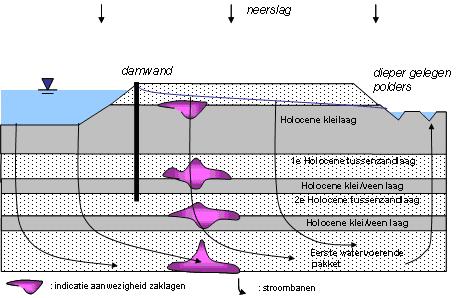After the remediation activities, the concentration of CVOC’s in groundwater declined significantly. However, after the active remediation rebound occured. BioSoil assumed that rebound was the consequense of the presence of DNAPl in poorly drained clay and peat layers.
During this pilot project, Deltares and BioSoil determinded if rebound is compenstated by degradation of the contaminant and if this means that a stable end situation has been reached.
Full report available in Dutch (see section Conclusion and Recommendations)

The remediation consisted of excavation, pump&treat and enhanced biological degradation by adding an electrondonor.
A combination of groundwater monitoring and modeling has been used to gain insight in distribution, degradation and rebound of the contamination.
- During 1.5 years, groundwater has been sampled and analysed on contamination, degradation products, redox parameters and electron donor.
- For the modeling, a groundwater and contaminant transport program has been used (Modflow and RT3D). A pumping test provided data for calabration of the model.
Groundwater flow
Based on field data, maps and modeling results, flow paths of the groundwater are understood. For the study site this showed that in a natural situation, the contamination will be transported vertically through the first layers of the soil into the aquifer. Potential transport of the remaining contamination to adjacent parcels will take place in the sandy aquifer. Rebound Monitoring data, the pumping test and monitoring indicate that rebound is taking place and will continue for decades. Degradation Concentration of the contaminant and degradation products during the monitoring period indicate that in the top layers of the soil profile degradation of CVOC is taking place to some extend but is probably being limited by a lack of electron donor. The DOC-concentrations (> 20 mg/l) seem to indicate sufficient electron donor to be present but hydrogen data show that this is probably not the case.In the deeper layers, redox circumstances are more favourable to reductive dechlorination. However, due to a lack of electron donor, degradation of the contaminants is just locally taking place.
This HIP-pilot shows how the combination of field data and modeling provides insight in the groundwater flow, rebound and biological degradation of the contamination. Those three aspects need to be assessed in order to determine whether a stable end situation is achieved.
The success of the applied remediation approach (pump&treat in combination with enhanced biological degradation) will be increased if attention is paid to the following aspects:
- Start by making a site conceptual model. It is important to have a good understanding of the soil profile, groundwater flow (directions), distribution paths of the contaminant, potential rebound effects.
- We advise to position filters of monitoring and extraction wells in one permeable layer. If the filter passes different layers, it is very difficult to interpret monitoring results. Besides, uncontrolled distribution of contaminants through filters should be prevented.
- Hydrogen field measurements should be applied to groundwater that can be sampled directly from the monitoring well in stead of sampling facilities at the end of long tubes.
